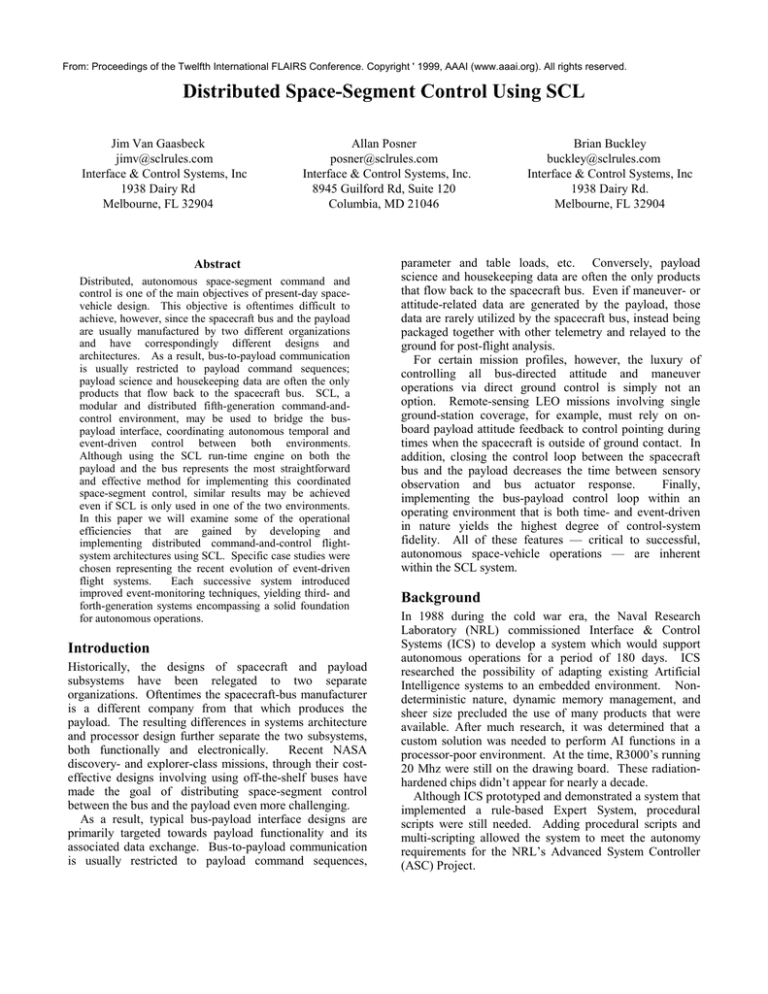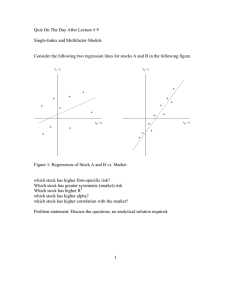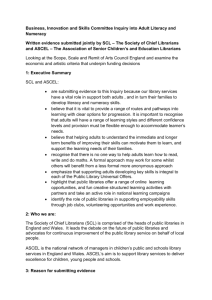
From: Proceedings of the Twelfth International FLAIRS Conference. Copyright ' 1999, AAAI (www.aaai.org). All rights reserved.
Distributed Space-Segment Control Using SCL
Jim Van Gaasbeck
jimv@sclrules.com
Interface & Control Systems, Inc
1938 Dairy Rd
Melbourne, FL 32904
Allan Posner
posner@sclrules.com
Interface & Control Systems, Inc.
8945 Guilford Rd, Suite 120
Columbia, MD 21046
Abstract
Distributed, autonomous space-segment command and
control is one of the main objectives of present-day spacevehicle design. This objective is oftentimes difficult to
achieve, however, since the spacecraft bus and the payload
are usually manufactured by two different organizations
and have correspondingly different designs and
architectures. As a result, bus-to-payload communication
is usually restricted to payload command sequences;
payload science and housekeeping data are often the only
products that flow back to the spacecraft bus. SCL, a
modular and distributed fifth-generation command-andcontrol environment, may be used to bridge the buspayload interface, coordinating autonomous temporal and
event-driven control between both environments.
Although using the SCL run-time engine on both the
payload and the bus represents the most straightforward
and effective method for implementing this coordinated
space-segment control, similar results may be achieved
even if SCL is only used in one of the two environments.
In this paper we will examine some of the operational
efficiencies that are gained by developing and
implementing distributed command-and-control flightsystem architectures using SCL. Specific case studies were
chosen representing the recent evolution of event-driven
flight systems.
Each successive system introduced
improved event-monitoring techniques, yielding third- and
forth-generation systems encompassing a solid foundation
for autonomous operations.
Introduction
Historically, the designs of spacecraft and payload
subsystems have been relegated to two separate
organizations. Oftentimes the spacecraft-bus manufacturer
is a different company from that which produces the
payload. The resulting differences in systems architecture
and processor design further separate the two subsystems,
both functionally and electronically.
Recent NASA
discovery- and explorer-class missions, through their costeffective designs involving using off-the-shelf buses have
made the goal of distributing space-segment control
between the bus and the payload even more challenging.
As a result, typical bus-payload interface designs are
primarily targeted towards payload functionality and its
associated data exchange. Bus-to-payload communication
is usually restricted to payload command sequences,
Brian Buckley
buckley@sclrules.com
Interface & Control Systems, Inc
1938 Dairy Rd.
Melbourne, FL 32904
parameter and table loads, etc. Conversely, payload
science and housekeeping data are often the only products
that flow back to the spacecraft bus. Even if maneuver- or
attitude-related data are generated by the payload, those
data are rarely utilized by the spacecraft bus, instead being
packaged together with other telemetry and relayed to the
ground for post-flight analysis.
For certain mission profiles, however, the luxury of
controlling all bus-directed attitude and maneuver
operations via direct ground control is simply not an
option. Remote-sensing LEO missions involving single
ground-station coverage, for example, must rely on onboard payload attitude feedback to control pointing during
times when the spacecraft is outside of ground contact. In
addition, closing the control loop between the spacecraft
bus and the payload decreases the time between sensory
observation and bus actuator response.
Finally,
implementing the bus-payload control loop within an
operating environment that is both time- and event-driven
in nature yields the highest degree of control-system
fidelity. All of these features — critical to successful,
autonomous space-vehicle operations — are inherent
within the SCL system.
Background
In 1988 during the cold war era, the Naval Research
Laboratory (NRL) commissioned Interface & Control
Systems (ICS) to develop a system which would support
autonomous operations for a period of 180 days. ICS
researched the possibility of adapting existing Artificial
Intelligence systems to an embedded environment. Nondeterministic nature, dynamic memory management, and
sheer size precluded the use of many products that were
available. After much research, it was determined that a
custom solution was needed to perform AI functions in a
processor-poor environment. At the time, R3000’s running
20 Mhz were still on the drawing board. These radiationhardened chips didn’t appear for nearly a decade.
Although ICS prototyped and demonstrated a system that
implemented a rule-based Expert System, procedural
scripts were still needed. Adding procedural scripts and
multi-scripting allowed the system to meet the autonomy
requirements for the NRL’s Advanced System Controller
(ASC) Project.
The days of large satellite programs were soon over, and
in came “Better-Cheaper-Faster” programs. Clementine
was one of the pioneering programs when it came to
“Better-Cheaper-Faster”. Clementine leveraged off the
ASC program and re-used the Spacecraft controller board,
and the SCL flight software. Just a couple of years earlier,
the Environmental Research Institute of Michigan (ERIM)
was in need of an autonomous robot controller to operate
an experiment in the shuttle bay. The ERIM Robot
Operated Materials Processing System (ROMPS) project
was to study the effect of semiconductor annealing in a
micro-gravity environment. ERIM also leveraged from a
previous program and used the SCL architecture to
automate the robot tasks and control equipment used for
the experiment.
These two programs helped start the evolution of the
SCL system. Lessons learned from one program were
incorporated into the next generation design.
Based on the publicity around the Clementine mission,
the Far Ultraviolet Spectroscopic Explorer (FUSE)
Program Management sought a solution to a shrinking
budget by re-using SCL across the system architecture.
The FUSE mission experienced significant budget cuts
which resulted in the mission being changed from a
geosynchronously-orbiting to a low-earth-orbiting satellite.
Planning algorithms which had previously been planned for
closed loop control using the ground system, needed to be
incorporated on-board. This required a smart, data-driven
architecture to control the Ultraviolet Telescope payload
and the spacecraft bus. In the FUSE section below, we will
examine the FUSE flight software architecture.
Although the FUSE mission offered many advances in
the SCL architecture, the Navy Earth Map Observer
(NEMO) takes the paradigm even further. The NEMO
spacecraft is a hyper-spectral imagery satellite requiring
management of high bandwidth image data, situational
awareness based on an on-board GPS receiver, and onboard Fault Detection Isolation and Recovery (FDIR).
Another on-going program is the Space Station’s Interim
Control Module or ICM. This is a quick turn-around
mission requiring FDIR capabilities and Autonomous
operations. The ICM system makes re-use of the SCL
software System as the Flight Controller software and has
re-packaged existing NRL booster technology. The SCL
software system architecture has been exploited to meet the
unique requirements of the mission.
The SCL System Architecture
The SCL system is an enabling core technology for
command and control applications. The SCL system
provides a seamless architecture between the ground and
space segments. Commonality is the key to software and
knowledge reuse. SCL is a hybrid system that employs a
rule-based, event driven expert system as well as a
procedural scripting capability. This portable architecture
allows a symmetrical software architecture between ground
and space and an inherent capability to reuse knowledge
from one phase of the development life cycle to another.
The SCL development environment consists of a ground
based Integrated Development Environment (IDE) used to
develop SCL scripts and rules. The SCL Real-Time
Engine (RTE) was designed to be portable and run in a
real-time embedded systems environment. The SCL RTE
represents the majority of the code necessary to implement
an embedded spacecraft controller. Early on, ICS saw the
need for the integration of ground and space operations
with a common control system using a single control
language. By using SCL in a distributed environment, the
command language for ground and space segments share a
common syntax. The SCL grammar is based on fifth
generation languages and is very english-like, allowing
non-programmers to write the scripts and rules that
constitute the knowledge base. Because the ground-based
SCL environment uses the same RTE as the spaceborne
controller, scripts and rules can be developed and
debugged on the ground-based RTE environment before
requiring the spacecraft hardware for final checkout.
This common architecture provides a capability to have
an on-board current value table. This allows the spacecraft
or payload to have knowledge of the current state of all
related sensors. On board software driven decommutation
is used to keep the database populated with current values.
Closed loop algorithms that previously had been executed
on the ground can now be executed in space.
Space-Ground Architecture
The SCL system consists of five major components:
• The database describes digital and analog objects that
represent spacecraft sensors and actuators. The latest
data sample for each item is stored in the database. The
database also contains derived items that are artificial
telemetry items whose values are derived from physical
sensors. Examples of derived items could be: average
temperature, power based on current and voltage
monitors, subsystem status variables, etc.
Data
structures required to support the Inference Engine are
also stored in the database.
• The SCL development environment includes an
integrated editor, the SCL compiler, decompiler, crossreference system, explanation subsystem, and filing
system. The development environment is also used as a
front-end to control the SCL RTE. A command window
is used to provide a command-line interface to the RealTime Engine.
• The RTE is the portable multi-tasking command
interpreter and inference engine.
This segment
represents the core of the flight software. This portion
shelf solution that is proven, can be quantified, and can be
replicated at will. Cost containment has mandated a
standard bus controller, standard interfaces to payloads,
and a conservative approach to newer technologies. For
this reason, the Payloads are sometimes more sophisticated
than the bus controllers. In these scenarios, systems like
SCL can be employed to offer a supervisory function for
the bus controller itself.
High-level interfaces between a payload and the bus
controller allow the payload to make bus-tasking requests.
In the case of FUSE, the payload is an Infrared Telescope
that will steer the bus as the satellite is in low earth orbit.
This architecture allows the more modern payload
controller to employ more cutting edge technology to effect
autonomous operations. High-level goals can be used to
task the bus; ephemeris data, slew commands, downlink
functions, and uplink functions can be placed under the
control of an intelligent payload controller. As you will see
in the next several sections, this capability has evolved
from its earliest beginnings, and still evolves today.
SCL for the ROMPS Program
Figure 1 - SCL Space Ground Architecture
of the software is written in C to allow ease of porting to
a specific hardware platform (ground or space).
• The Telemetry Reduction program is responsible for
filtering acquired data, decommutation (if necessary),
storing significant changes in the database, and
presenting the changing data to the Inference Engine.
• The project is the collection of SCL scripts and rules
that make up the knowledge base. On the ground-based
systems, the project contains an integrated filing system
to manage the knowledge base.
In the space
environment, the binary knowledge base is uploaded to
the spacecraft and stored in memory.
Depending on the needs of the user, all components of
SCL can be run on a single system, or may be distributed
among systems; see Figure 1.
The development
environment can be used to directly connect to a local or
remote version of the SCL RTE. This direct connect
capability is also supported for the space segment to allow
interactive commanding and query of the system.
Space-Space Architecture
Catalog shopping has invaded every facet of our lives.
NASA can now shop for satellite busses by catalog also.
This fixed-price turn-key approach has led to cost savings
for NASA, but has required that vendors offer an off-the-
The Environmental Research Institute of Michigan (ERIM)
was awarded the Robot Operated Material Processing in
Space (ROMPS) program. ERIM needed an experiment
controller that would fly on the shuttle for 11 days and
operate while the astronauts slept. The ROMPS mission
used a derivative of an industrial robot that utilized a 3
degree of freedom arm. The ROMPS experiment was used
to investigate the effects of high temperature annealing in a
low-G environment on semiconductor materials. The robot
was tasked to move more than 200 pallets of semiconductor
material into an annealing oven for a specified period of
time. The experiment was required to be fully autonomous
and be performed on an aggressive budget.
ERIM re-used a spacecraft controller from a previous
project without modification. New I/O devices were added
to control the robot, the oven and a capaciflector
experiment. The System Controller software was based
around SCL and remained largely unchanged. The SCL
software allowed ERIM to re-load the on-board database to
describe the hardware devices. The control algorithms
were written in the form of SCL scripts and rules. Scripts
and rules are analogous to the Command Store Memory
(CSM) on most satellites. Scripts and rules are written in
the SCL high-level scripting language and are designed to
be reloaded on a daily basis, or they can remain resident for
the life of the program.
The SCL software uses a data driven approach to define
the unique requirements of each mission. The SCL
database allows the end-user to define the characteristics of
all sensors and effectors. The sensors can also be sampled
on-board and decommutated to allow visibility into the
current value for each device. This allows closed-loop
control algorithms to be executed on-board. The low-level
acquisition software and the I/O driver-level interfaces are
normally customized for each program. The uplink and
downlink protocols are also normally customized for the
mission. Air Force, Navy, and NASA missions often use
different uplink and downlink protocols.
The ROMPS program was able to get a jump-start by
having the bulk of the on-board controller software done
before the project began. ROMPS was a second-generation
SCL system for ERIM.
Since the SCL system is symmetrical and uses the same
architecture for the ground systems, SCL was also used for
desktop simulation of spacecraft subsystems, the testset
control system, and as the operational ground control
system.
Early prototyping of spacecraft systems with a software
simulation allowed for the development of the software
control system in parallel to the hardware development.
The engineers were able to develop control system
scenarios and stimulate them in desktop environment. As
hardware became available, testing could be performed
with hardware in the loop. This configuration allows a
step-wise integration of hardware with a software
simulation of missing components; see again Figure 1.
The ROMPS testset consisted of off-the-shelf hardware
and software. The National Instruments LabViews product
and the SCL system were used to control the testset. SCL
contains bridge code to the LabViews interface. LabViews
was used as the visualization system and for much of the
board level hardware control. The SCL system was used to
script test procedures. A detailed set of LabViews screens
was developed by the customer to show the robot arm
angles and the "bins" containing pallets of semiconductor
material. Screens were also defined to monitor and control
the annealing oven.
SCL includes a module called DataIO, which is used to
decommutate and store telemetry. The log files are in
standard formats, which can be translated and analyzed,
using Microsoft Excel spreadsheets and graphs. Again,
inexpensive off-the-shelf tools were used for data analysis.
Since the ground control system was largely the same as
the testset, many of the SCL scripts and rules which were
tested during I&T could be used for operational control.
The LabViews screens were also re-used for real-time
operations. The scripts and rules were designed in a
manner which allowed them to be used in the test
environment as well as migrated onto the spacecraft.
The ROMPS mission was launched on September 9,
1994 on STS-64.
The 11-day mission was 100%
successful. The SCL system processed more than 200
semiconductor material samples while the astronauts slept.
The ROMPS hardware was located in a “Get-Away
Special” (GAS) canister located in the shuttle's payload
bay. The SCL system was running on a 12 MHz 80286
"look-alike" with ceramic parts. The ground system was a
distributed network of personal computers at Goddard
Space Flight Center connected to the NASA Hitchhiker
interface.
SCL for the Clementine Program
The Clementine (AKA Deep Space Probe Science
Experiment) spacecraft was a BMDO/NRL sponsored
program that tested lightweight BMDO sensor technology
while gathering science data. The Clementine program was
the first of the “Better, Cheaper, Faster” missions. It went
from “vaporware” to hardware in 18 months. The mission
cost ~$75M with $50M of the cost for the Titan II rocket.
The Clementine vehicle was launched in February of 1994.
The primary mission was to map the surface of the moon
for the first time since the Apollo days, and to perform an
asteroid intercept in deep space.
After orbiting the Earth for a brief period, the
Clementine vehicle was sent on a trajectory that took it to
the moon, where it entered a lunar orbit. The probe was in
lunar orbit for several months and returned more than 1.5
million images detailing lunar soil mineral composition.
The Clementine mission achieved all mission objectives
with the exception of the asteroid intercept.
The SCL system was used on-board the Clementine
spacecraft to perform TT&C functions, system health and
welfare monitoring and anomaly resolution. The mission
required a high degree of autonomy and made extensive
use of the SCL command and control capabilities. The
Clementine mission took a conservative approach and only
used the scripting capabilities of SCL for the main mapping
phase of the mission. Once the entire moon had been
mapped using on-board sensors, autonomous operations
were tested. Autonomous mapping was achieved by using
SCL rules to trigger data collection based on spacecraft
position.
SCL
RTE
SCL Scripts
& Rules
A
C
T
U
A
T
O
R
S
Commands
Change
Notice
TM
Reduction
SCL C&T
Database
Uplink
Handler
Change
Data
TM
Acquisition
Uplink
GN&C
TM
Downlink
Formatter
Downlink
S
E
N
S
O
R
S
Data
Samples
Log
Solid
State
Recorder
Images
R3000
Image
Controller
Figure 2: Clementine Flight Software Architecture
The SCL system follows an open-systems approach
allowing other tasks to communicate with SCL on the
ground, and in space. For Clementine, the SCL system was
required to have bi-directional communications with the
Guidance, Navigation and Control (GNC) algorithms
which were written as another task; see Figure 2.
Sequencing of the spacecraft maneuvers are handled by
SCL, but the low-level thruster pulse commands are
handled by the GNC software. Attitude information is
reported back as telemetry, allowing the SCL expert system
to inference on the changing data. The SCL Flight
Software used on Clementine was largely re-used from
another Naval Center for Space Technology (NCST)
satellite program.
The Clementine flight software design closely mirrored
that of the ROMPS mission. The Clementine flight
processor is the MIL-STD-1750A and uses the Ada version
of the SCL Real-Time Engine. SCL was also used on the
ground system to develop mission tasking loads and
interface with the existing ground control system. The
Clementine program achieved a significant science return
and for an unheard of budget. The Clementine mission has
been held as a model of the "Better, Cheaper, Faster"
philosophy to be adopted by NASA space programs.
SCL for the FUSE Program
The Far Ultraviolet Spectroscopic Explorer (FUSE), a
NASA-supported, Earth-orbiting mission scheduled for
launch in the summer of 1999, is designed to investigate
basic physical processes in the universe. Through NASAdirected restructuring, the mission architecture has evolved
to include a low-earth-orbiting satellite, utilizing significant
on-board and related ground-segment autonomy, and an
autonomously-controlled ground station. As a result, the
Johns Hopkins University (JHU), who leads the
development of this first in the series of Mid-Explorer
(MIDEX) missions, investigated options for reducing the
costs of development and operations, while minimizing
project risk. SCL, whose artificial intelligence capabilities
and Expert Systems Technology were successfully used on
the Clementine mission, was specifically selected as the
basis for the combined, autonomous space- and groundsegment development and operation.
FUSE Spacecraft operations are controlled by the
Central Electronics Unit in the Spacecraft bus. A separate
subsystem, the Instrument Data System (IDS), controls the
operation of the FUSE far-ultraviolet (FUV) telescope.
The IDS contains a level of sophistication that exceeds that
of many spacecraft controllers. IDS features include a
moderately-powerful CPU (a 17-MHz Motorola 68020), a
large stored-command memory, and the SCL expert system
used for stored-command processing. Virtually all science
operations, as well as Spacecraft pointing functions, are
controlled via the IDS.
All IDS software tasks are “expert system aware". Each
task implements a set of event triggers that can be used, at
the discretion of the FUSE planners and operators, to
trigger SCL rules. Although the IDS also provides the
capability to decommutate telemetry from IDS telemetry
packets, routine events are sent directly to the SCL expert
system so that any rules associated with an event can be
evaluated with a minimum of overhead. SCL rules can be
associated with event triggers. When an event occurs, any
rules associated with the event are executed by the SCL
expert system. Rules in turn can execute SCL scripts. A
rule is a simple If-Then type of statement that is compiled
as an individual SCL code block. A script is a block of
IDS commands and SCL statements that are similar to a
typical stored-command list. Any combination of rules and
scripts can be stored in the IDS on-board memory.
Because the IDS operates in an event-driven manner,
many activities that would traditionally be initiated via
time-based commands may instead be initiated using rules
that respond to event triggers. The event-driven nature of
the IDS promotes increased operational efficiency by
allowing observation steps to proceed as quickly as
possible and supports modular stored-command loads that
are largely reusable.
Ultimately one of the most important lessons learned
from the FUSE development effort lies with the flight SCL
scripts. Those scripts, combined with the capabilities of
the IDS-based SCL RTE, possess the unique ability to
interact with the spacecraft attitude control system (ACS)
in an event-driven environment; despite the fact that the
ACS is not based on the SCL architecture.
As Figure 3 indicates, FUSE coarse attitude is
maintained to an accuracy of 2 degrees using only coarse
sun sensors, magnetometers and torquer bars. Once fineattitude control has been achieved, the ACS IRU and the
reaction wheels can maintain an attitude accuracy of 10
arcminutes. The unique, closed-loop, control-concept
FUV
Detectors
FES
Images &
Centroids
Peakup
Data
IDS
with
SCL
Fine Pointing Data (FPD)
(quaternions) [~ 1 asec.]
C&DH
Slew
Status
IRU
Rates
[~10 amin.]
Reaction
Wheels
ACS
Coarse
Sun
Sensors
Magnetometers
Coarse Attitude
Vectors [~2 deg.]
Torquer
Bars
Figure 3: FUSE Attitude Control Concept
employed on FUSE involves the sending of Fine Pointing
Data (FPD) from the IDS to the ACS. The FPD, obtained
through the processing of visible star data from the Fine
Error Sensor (FES) and FUV-detector count-rate data, are
sent by the IDS to the ACS and are processed to maintain a
pointing accuracy of less than 1 arcsecond. As part of the
closed-loop feedback process, the ACS sends “slewcomplete” messages back to the IDS.
As such, not only will the IDS be able to direct ACSbased slews via the fine-pointing directives that it sends,
but it will also be able to operate closed-loop with the
ACS, starting its next activity upon receiving the slewcomplete flag from the ACS. It is this ability to operate
between disparate flight-hardware environments that is one
of the true strengths of the FUSE IDS-based, SCL
implementation.
•
•
•
•
•
computational power
On-board data storage (48 gigabit)
High data rate X-Band Downlink (150 Mbps)
Low data rate S-Band Tactical Downlink (1 Mbps)
Commercial satellite bus (Space Systems Loral LS-400)
Preconfigured
Interface
(PCI)
for
secondary
payloads/experiments
SCL for the NEMO Program
The Naval EarthMap Observer
(NEMO) is a space-based remote
sensing system for collecting broadarea, synoptic, and unclassified
Hyperspectral Imagery (HSI) for Naval Forces and the
Civil Sector. NEMO meets unique requirements for
imaging the littoral (shallow water) regions on a global
basis, and also meets civil needs for imagery supporting
land use management, agriculture, environmental studies,
and mineral exploration.
NEMO provides:
• HSI to characterize the littoral battlespace environment
and to support littoral model development;
• Automated, on-board processing, analysis, and feature
extraction using the Naval Research Laboratory's
(NRL's) Optical Real-Time Adaptive Signature
Identification System (ORASIS)
• Demonstration of real-time tactical downlink of
hyperspectral end products directly to the field to
support the warfighter.
• HSI for Department of Defense (DoD) usage and for
civil applications such as environmental monitoring,
agriculture, land use, geology/mineralogy, and
hydrology; and
• A cooperative industry and government program to share
costs and leverage system utility under the Defense
Advanced Research Project Agency's (DARPA) Joint
Dual Use Application Program (JDUAP)
Spacecraft and Payload Characteristics:
• Hyperspectral Coastal Ocean Imaging Spectrometer
(COIS) provides moderate spatial resolution with a
30/60 meter ground sample distance (GSD) and a 30
km swath width
• High spectral resolution of 10 nanometers with a spectral
range of 400 to 2500 nanometers
• Panchromatic Imaging Camera (5 meter GSD) coregistered with the Coastal Ocean Imaging
Spectrometer
• Real-time feature extraction and classification with
greater than 10x data reduction using NRL's ORASIS
algorithm
• High-performance Imagery On-Board Processor (IOBP)
provides greater than 2.5 gigaFLOPS of sustained
Area
of
Interest
Figure 4: NEMO Mapping Scene Generation
FUSE observation planning and scheduling is performed
at the ground system and then an observation plan, in the
form of SCL scripts and rules, is sent from the satellite
control center (SCC) to the FUSE payload controller.
Once the plan is executed on board, much of the tasking
proceeds in an event-driven manner. A fairly significant
amount of detailed planning at the SCC is required,
however, to build each uploaded plan. NEMO’s designers
seek to reduce some of the routine-image planning
activities by moving them on-board the payload controller.
The goal is to allow NEMO’s controllers to concentrate on
the images rather than the mechanics and details of
capturing each image.
The NEMO payload-controller software takes a modest
step towards implementing on-board image planning.
Although significant capabilities could have been exploited
on the NEMO program, the system designers were careful
to set achievable goals for on-board autonomy and image
planning. On NEMO, SCL will be used to automate
operations and support FDIR in much the same way it will
be used on FUSE. This reuse of software and operations
concepts will help reduce the risk to the NEMO program.
The addition of on-board imaging planning is what will
set NEMO apart from FUSE. NEMO’s on-board imageplanning capability will build on the event-driven
commanding foundation established by the FUSE software.
A separate image-planning task will be added to the
payload controller software to transform high-level imaging
commands into imaging events and into the lower-level
commands needed to actually collect and process an image.
Imaging events are the messages that are sent to the SCL
software that cause it to evaluate SCL Rules and,
consequently, to execute the image tasking. The low-level
commands are the actual commands sent to the camera
controllers, attitude control system and the solid state data
recorder among others.
A NEMO imaging command contains many information
fields describing the location of the imaging target and the
desired sensor configuration. Target location information
includes the target’s starting latitude and longitude, its
ending latitude and longitude and the sensor “look” angle
to an arbitrary point in the target field; see Figure 4.
Sensor configuration information includes which cameras
are to be used for an image and the image-processing
configuration.
Up to 9 Image commands are batch processed by the
NEMO image planning software. Current operations
concepts have this occurring about one orbit ahead of the
actual imaging orbit. The batch processing will yield a
sensor event table that feeds the imaging events to the SCL
software and an attitude control system slew table that
specifies the spacecraft slews needed to capture the entire
sequence of up to 9 image swaths.
When the actual imaging time arrives, the events in the
table are distributed to the SCL software and the spacecraft
slews to each image target starting point. The events are
used to trigger SCL rules that in turn execute on-board
software that extracts the camera configuration data from
the currently-executing imaging command and then
decomposes the information into the required low-level
commands. This continues until each of the imaging
commands has been executed for the current orbit. When a
new orbit begins, a new set of tables will be available to
control the next imaging sequence.
At all times, SCL rules will be monitoring the progress
of the imaging sequence along with the payload subsystem
health in general. If need be, the rules can abort an
imaging sequence and place the payload into a safe, idle
configuration.
It is hoped that this enhanced planning capability will
allow NEMO’s mission planners to concentrate on the
images that are to be acquired rather than the details of how
to acquire each image. This is important because, as a dual
government and commercial spacecraft, the demand on
NEMO’s imaging resources will be significant.
Conclusion
In order for future low-cost missions to achieve the
scientific throughput required by the increasingly
demanding public and private sectors, in-flight autonomy
must be implemented. Despite the fact that proposed
decreases in ground-station coverage and operations
personnel have provided the catalyst for implementing onboard autonomy, progress has nonetheless been slow and
stepwise. All too often, the desire to implement a
technological quantum leap has been all but thwarted by
the need to guarantee mission success. In addition, despite
the existence of proven, COTS-based systems for
implementing autonomy, companies still shy away from
technologies that are “Not Invented Here (NIH)”.
Another factor in slowing the inclusion of automation
has been the NASA desire to do “mail order shopping” for
satellites. Purchasing a satellite bus from a catalog has
forced satellite manufacturers to use conservative (i.e.,
outdated) design approaches to the Satellite Control
Computer. These “off the shelf” spacecraft offer a turn-key
bus which provides a payload plate, a power harness, and
data harness, such as a 1553 bus. This philosophy offers
no incentive for automation of the Bus Controller;
consequently, the new payload controllers are more
sophisticated than the bus controller itself.
Without a doubt, experiences from projects such as
FUSE and NEMO serve well to demonstrate the
tremendous benefit of using an extensible, modular
environment, such as SCL, to close the control loop
between the spacecraft bus and the payload. SCL’s eventdriven architecture simplifies what used to be time-linebased operations, so that space systems can now be
designed around discrete events and goals. Accordingly,
through using SCL, the bus-payload interface becomes
somewhat more transparent, facilitating autonomous
temporal and event-driven control between the two
otherwise disparate environments and resulting in
tremendous operational-cost savings throughout mission
life cycles.
References
Interface & Control Systems Inc. Home Page
http://www.sclrules.com
FUSE Home Page
http://fuse.pha.jhu.edu
NRL NEMO Public Home Page:
http://nemo.nrl.navy.mil/public/index.html
NRL ICM Public Home Page:
http://issbus.nrl.navy.mil








